Mon 22 Jun 2009
NGAIO MARSH – Enter a Murderer. Pocket 113, paperback reprint; 1st US printing, July 1941. Previously published in the UK by Geoffrey Bles, 1935. Reprinted many times, in both hardcover and soft, including (and shown): Berkley F703, US, 1963; Fontana, UK, pb, 1968, 1983; St.Martin’s, US, pb, 1998.
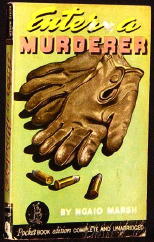
I’m far from being an expert on Ngaio Marsh, so I can’t tell you what the circumstances were that Enter a Murderer was published for the first time in the US as a Pocket Book paperback, and not as a hardcover. But I imagine the story’s known, and perhaps someone reading this who can fill in the details will do so. (I’ve found nothing on the Internet so far that’s relevant.)
Enter a Murderer was only her second novel, which may be part of the explanation, and the first of five detective novels Marsh wrote which took place in the world of the theater, one of the loves of her own long life. (She was born in 1895, most reference sources say, and passed away in 1982.)
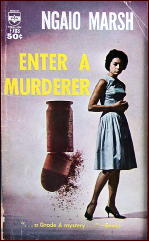
Dead is an actor, shot to death onstage, with dummy bullets having been replaced with live ones in the gun another actor used as part of the play, with the two directly facing each other.
That the dead man was a blackmailer (as it is soon discovered), a womanizer and a thwarted lover (as was well known), plus various and sundry other flaws, gives a motive to everyone on or near the stage. A blackout to open the final act gave everyone an opportunity.
The investigation that results, carried out by Chief-Det. Inspector Alleyn (primarily) and his assistant on the case, Inspector Fox (secondarily), is both aided and abetted by news journalist Nigel Bathgate, a friend of Alleyn whom he invited to the play, which they watched together to its final and deadly conclusion.
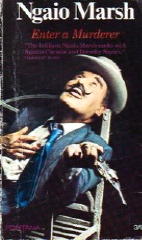
It’s not always an easy relationship. Bathgate is willing to let Alleyn censor his reporting, but he’s not always inclined to ask potentially embarrassing questions of friends who happen to be under suspicion.
Sometimes the investigation (from the reader’s point of view) is told with Alleyn as the protagonist, and sometimes it’s from Bathgate’s point of view. It’s a combination that Marsh may have thought she needed to present the story more efficiently from several angles, but it’s not as smoothly done as I thought it might have.
The action in and around the stage is clearly delineated, though, many times over, even to a final reconstruction of the crime at the end – always a welcome touch in classical detective fiction, resembling as it does the “isolated country house” theme in certainly the most essential way.
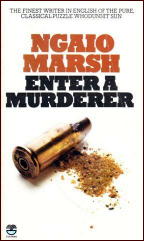
But the business of the blackmail never seems to be addressed directly. It’s as if it were shunted to the side, not abruptly, but Marsh never seems to tackle it head on, leaving the motive for the killing murky, while a full spotlight is shed upon the setting. (At times you can all but smell the greasepaint.)
Upon finishing the book I was more than satisfied with the solution – nicely done – but I’m still uneasy about there being some loose ends that I didn’t (and still don’t) feel as though they were wrapped up properly enough.
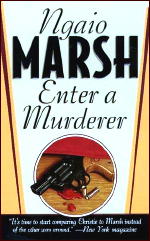
This has nothing to do with the actual solution, mind you. I like the ending well enough that I haven’t felt the need to poke around into that pile of red herrings stacked over there in the corner (figuratively speaking). It’s just the sense that I ought to, in order to give you an honest report.
But I’ve decided not to – go back through the book and poke around, that is – and what you’ve just read is as honest as it’s going to get.
Do I recommend the book? Yes, I do, but I assume you’ve already read and recognized all of the caveats (both major and minor) for what they’re worth as well.
June 23rd, 2009 at 1:38 am
Thankfully Marsh got a lot better than this. I never did warm to her theatrical settings despite her love of them, but she became one of the four major women in the British classical school and Alleyn one of the most attractive tecs of that school.
Luckily Bathgate and the experiment with alternating points of view was only a brief experiment.
Barzun and Taylor are effusive about this one, but I didn’t feel the same. On the other hand they didn’t care for Dead Water which I thought was one of her best, and I liked Died in the Wool better than they did too.
Some of her later books like Clutch of Constables, Singing in the Shrouds, When in Rome, and Hand In Glove were still quite good, which isn’t always true of Christie and Allingham at that stage.
Later of course Alleyn acquired his redoubtable Sgt. Fox and artist wife Agatha Troy (can’t say why, but Alleyn, Michael Innes Appleby, and John Creasey’s John Mannering the Baron all married artists — and all portraitists. I suppose because a woman artist was at once respectable and a little racy). Nicholas Blake’s Nigel Strangeways was married to an explorer, and of course Harriet Vane in the Lord Peter books was a mystery writer. I can’t recall what Albert Campion’s wife was, save infinitely patient.
It’s entirely possible that Marsh’s early books didn’t all do well enough to interest an American publisher until later when the paperback revolution was on. A Man Lay Dead was her first and may not have done that well here. I’m not sure when her American reputation began.
Debuting in 1934 she was the last of the four major women writers of the British school to get into print, four years behind Allingham who was a decade behind Christie and seven years behind Sayers.
I’m not sure exactly when Marsh was recognized as one of the mistresses of the form, but it may have been with 1936 Death in Ecstasy, her third or fourth book, and an early example of the mystery set against the background of a bizarre cult.
December 22nd, 2009 at 3:26 pm
“Enter A Murderer” was a vast improvement compared to Ngaio Marsh’s first Inspector Alleyn mystery – “A Man Lay Dead”. I’ve read only the first 6 books in the series, but it is apparent that Marsh was experimenting and more importantly improving with each book.
It is unfortunate that her works are not as popular with Americans today, many of whom do not know about her works in part because many bookstores do not even stock her works. Plus, the BBC TV series of “Inspector Alleyn” are so changed that it bares little resemblance to the written work.
IMO, in terms of the mechanics of the murder, Marsh is not quite on par with the great Agatha Christie, but her’s is a much improvement over Margery Allingham. Marsh’s plot has a certain pace about it that I find more pleasing than Christie or Allingham.
It is a mystery in itself that Marsh does not seem to enjoy the same fame or notoriety with American readers as Christie.